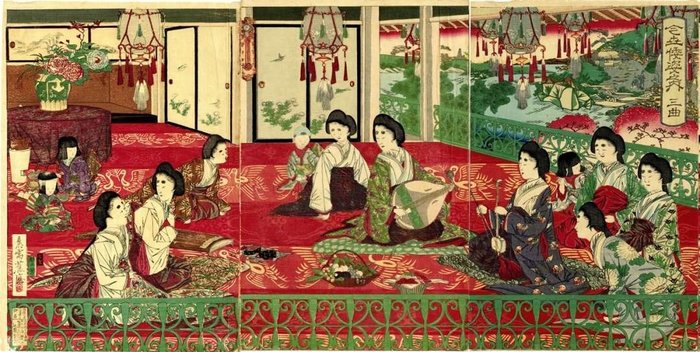N. 92341363

“Kinse yamato sugata no uchi-sankyoku” 今世倭姿之内 三曲 ”(Kotokyoku in the appearance of modern Japan) - Mishima Shōsō (1852‐1914) - Giappone - Periodo Meiji (1868-1912)
N. 92341363

“Kinse yamato sugata no uchi-sankyoku” 今世倭姿之内 三曲 ”(Kotokyoku in the appearance of modern Japan) - Mishima Shōsō (1852‐1914) - Giappone - Periodo Meiji (1868-1912)
Original woodblock print,-Mishima Shōsō(1852‐1914) – “Kinse yamato sugata no uchi-sankyoku”今世倭姿之内 三曲 ”(Kotokyoku in the appearance of modern Japan) -Japan – ca 1905 (meiji 11 period) May
The signature is ‘Ouju Shōsō’応需蕉窓
This work was drawn by Mishima Shosou.
Mishima Shosou studied painting under the Shijo school painter and Kikuchi Yosai.
Therefore, it is a different style of ukiyo-e from the Utagawa and Tsukioka ukiyo-e.Also, He also painted ukiyo-e late, so there aren't many works.
This woodblock print has 3 pieces glued together
See Ritsumeikan University ARC: https://www.dh-jac.net/db/nishikie/kuniS60-0232-1/portal/
memo
A student of Kikuchi Yosai(菊池溶斎). His real name is Mamoru Mishima(三島守), commonly known as Yunosuke(雄之助).
He used the surname Shōsō(蕉窓), Shōsō(蕉叟), and Shōrou(蕉老).
At first, after studying Japanese painting of the Shijo school, he studied under Kikuchi Yosai, and under the free and open guidance, he honed his painting skills and was good at figure painting and bird-and-flower painting.
In the early Meiji era, he drew sketches for temporary crafts, illustrations for newspapers, magazines, and books, but gradually became more prominent.
“Person(人物)” and “Kacho(花鳥)” was selected, and then “Tsuta(蔦)” was announced at the first competition of the Kangakai in 1885, and was highly praised by art critic Fenollosa.
Furthermore, in 1886 (Meiji 19), he exhibited “Children’s Dragon(子母龍)” at the 2nd Kangakai Convention and received an award. He is good at figure painting, landscape painting, and bird-and-flower painting, and made his name in the Kanto art gallery as a student of Yosai along with Watanabe Shotei(渡邉省亭) and Matsumoto Kaedeko(松本楓湖).
When the exhibition became popular,
Shōsō began to refrain from exhibiting, and after the Meiji 30 period(1897~), he specialized in illustrations for books.
Questo oggetto era presente in
Come fare acquisti su Catawiki
1. Scopri oggetti speciali
2. Fai l’offerta più alta
3. Paga in tutta sicurezza
